The Easiest Way To Relieve Foot and Toe Pain While Lounging on the Couch, According to a Podiatrist
As a former ballet dancer, I know a thing or two about toe and foot pain. Throughout my years of cramming my toes into satin-covered torture devices (er, pointe shoes) and then pushing my good-as-flat feet into arched shapes that they resisted at every turn, I experienced quite a few common foot problems: blisters, plantar fasciitis, Achilles tendonitis, and if I hadn’t stopped sooner, probably bunions, too. Though I managed a few of these conditions myself with resistance-band stretching, foot massage, and a whole lot of ice, I also sought the advice of medical professionals—and talking to the pros led me to discover the best podiatrist-recommended toe separators.
- Daniel Pledger, DPM, podiatrist and founder of ePodiatrists
- Emily Splichal, DPM, board-certified podiatrist and human movement specialist, and global leader in barefoot science and rehabilitation at the Center for Functional and Regenerative Podiatric Medicine
- Marion Parke, DPM, podiatrist and luxury shoe designer
- Stephen Pasterino, founder of ThreeForm and P.volve
Best toe spacers at a glance
- Best podiatrist-recommended toe separators: SoftStar Shoes, Correct Toes, $65
- Best toe spacers for bunions: YogaToes, Original YogaToes, $37
- Best toe spacers for walking: Mind Bodhi, Toe Separators, $10
- Best toe separator socks: MyHappyFeet Original Foot Alignment Socks, $29
- Best single-toe spacers: Pedifix, Visco-Gel Toe Spacers, $8
- Best customizable toe spacers: Povihome, Toe Sleeves, $10
{{post.sponsorText}}
What are toe separators?
Toe separators (also called toe spacers, toe spreaders, or toe stretchers) look similar to the foam toe holders that keep nail polish from smudging during pedicures, but these specific versions are made of a sturdier material like medical-grade gel or silicone. They work by helping to realign toes to their rightful position while providing a gentle stretch. To use them, you just slide each of your toes into the designated holes, and… that’s it. Larger types like YogaToes are meant to be worn barefoot and while off your feet—so, you can just pop them on while watching TV, and let them do their thing—while smaller models with a flatter profile can be worn in shoes.
Do podiatrists recommend toe separators?
Almost every podiatrist I saw about my foot problems recommended I use toe separators. And, beyond being extra-helpful for realigning the toes of those who shove their feet into confined spaces (looking at you, wearers of pointy-toed shoes), podiatrists say that there are other toe spacer benefits to consider.
“I recommend toe separators to almost all my patients,” says podiatrist Emily Splichal, DPM. “I find that they’re a great way to stretch the small muscles around the toes as well as the toes themselves.”
And since toes and feet bear your full body weight with every step, toe flexibility is no small issue. “If the big toe can’t flex very well, you’ll land differently, and it really sets up a lot of imbalance in the chain of muscles and into the hip,” Stephen Pasterino, the founder of P.volve in New York City, previously told Well+Good. Without toe flexibility, your plantar fascia (which spans the length of your instep) can also lose its ability to absorb shock well, putting you more at risk for plantar fasciitis, too.
“Toe separators are a great way to stretch the small muscles around the toes as well as the toes themselves.” —Emily Splichal, DPM
Beyond their preventative powers, though, toe separators can also mitigate the foot and toe pain that may result from regular walking or running, and may also help slow the progression of common toe conditions. “People with hammertoes, bunions, and neuromas will all benefit from toe separators,” says Dr. Splichal. While some severe cases of these conditions could require more intense treatment, she still suggests that her patients with rigid hammertoes or severe bunions incorporate toe separators into their daily routines. “Bringing even a little mobility and alignment of the forefoot is beneficial,” she adds.
Do toe spacers really work?
Particularly in the case of bunions, recent research backs Dr. Splichal up: A 2021 meta-analysis1 found a combination treatment of toe separators, exercise, night splints, and dry needling was the best choice for reducing bunions. In addition, a small 2018 study of 56 women with moderate bunions published in the Journal of the American Podiatric Medical Association also found pairing toe separators with foot mobilization exercises resulted in a significant reduction in bunion severity at the mark of one year of use.
Dr. Splichal has found that the results from toe separators tend to be more pronounced in her patients who wear them more regularly. But as is true with any stretching, it’s best to start slow at first, wearing the toe separators for a few minutes each night, then increasing the length of time as you get used to them. “Typically, I find patients can only wear them for so long, so I advise people to listen to their bodies and take them off whenever they become irritating,” says Dr. Splichal. Below, we’ve rounded up a few of our favorite toe separators to get you started.
The best, podiatrist-recommended toe separators to try for foot or toe pain:
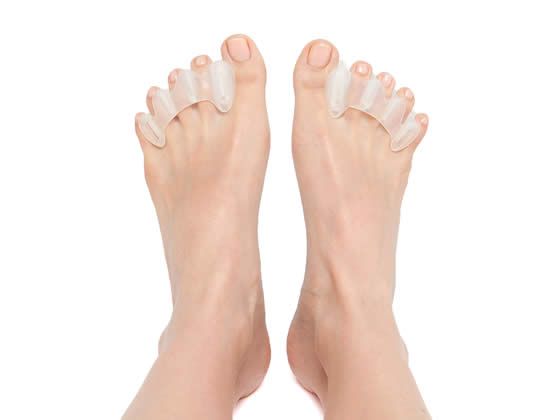
Sizes: women’s 5-13, men’s 6-11.5
Correct Toes are the separators that Dr. Splichal most often recommends to her patients. Made from medical-grade silicone, they’re small and slim enough to wear in your sneakers so they work while you’re on the go. They’re also available in four unisex size options that cover a wide range of men’s and women’s shoe sizes.
Colors: Clear
Pros:
- Can wear inside shoes
- Wide size range
- Made from flexible, medical-grade silicone
Cons:
- Priciest pick on this list
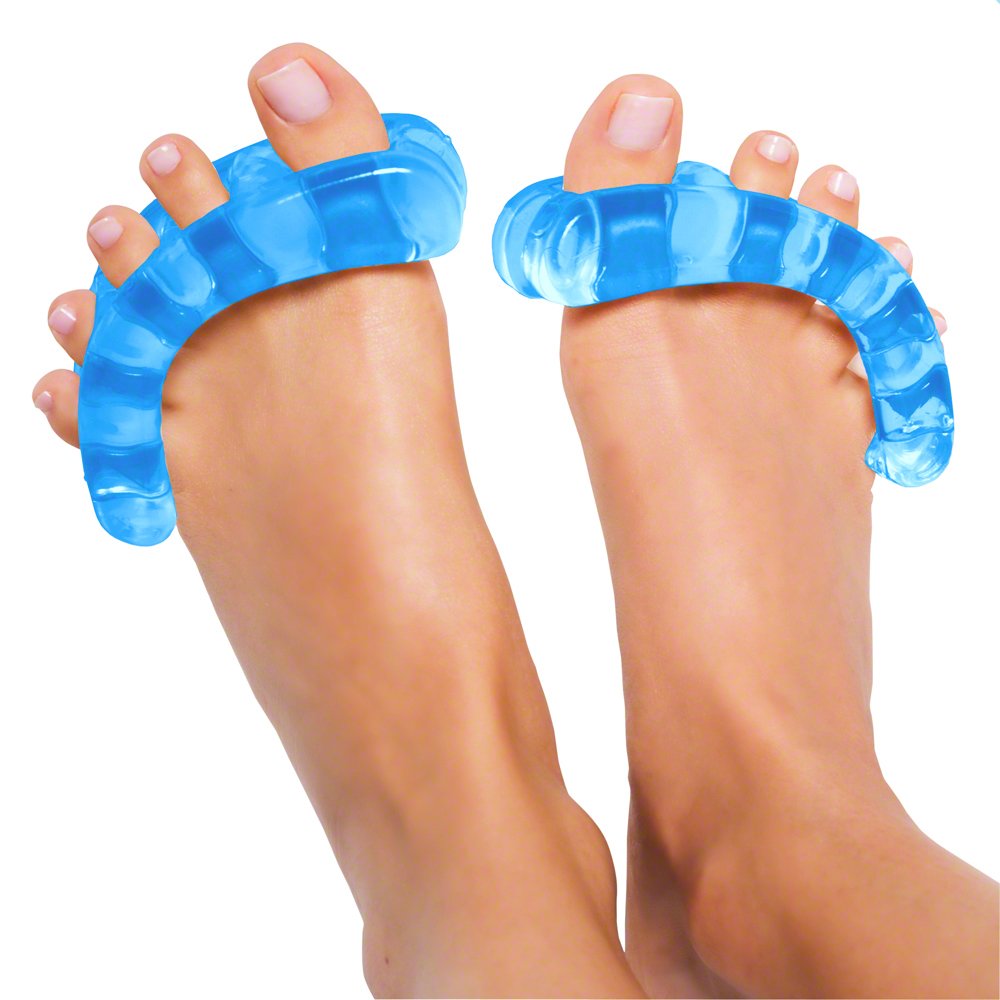
Sizes: Extra Small (Women’s 5-7), Small (Women’s 7.5-11)
YogaToes are an original of the toe-separator category and a top pick on Amazon among reviewers with bunions. Made from a BPA-free, medical-grade gel, many people comment on their durability. YogaToes’ sizing appears a little restrictive, but one of their two size options will likely work for women’s shoe sizes 5-11. Note that, unlike the Correct Toes option above, these toe spacers are designed to be worn while relaxing, as the supportive bottom piece makes them too bulky for wearing in shoes.
Colors: Blue
Pros:
- Highly rated by customers with bunions
- Durable material
Cons:
- Too thick to wear with shoes
- Not as many size options as other picks
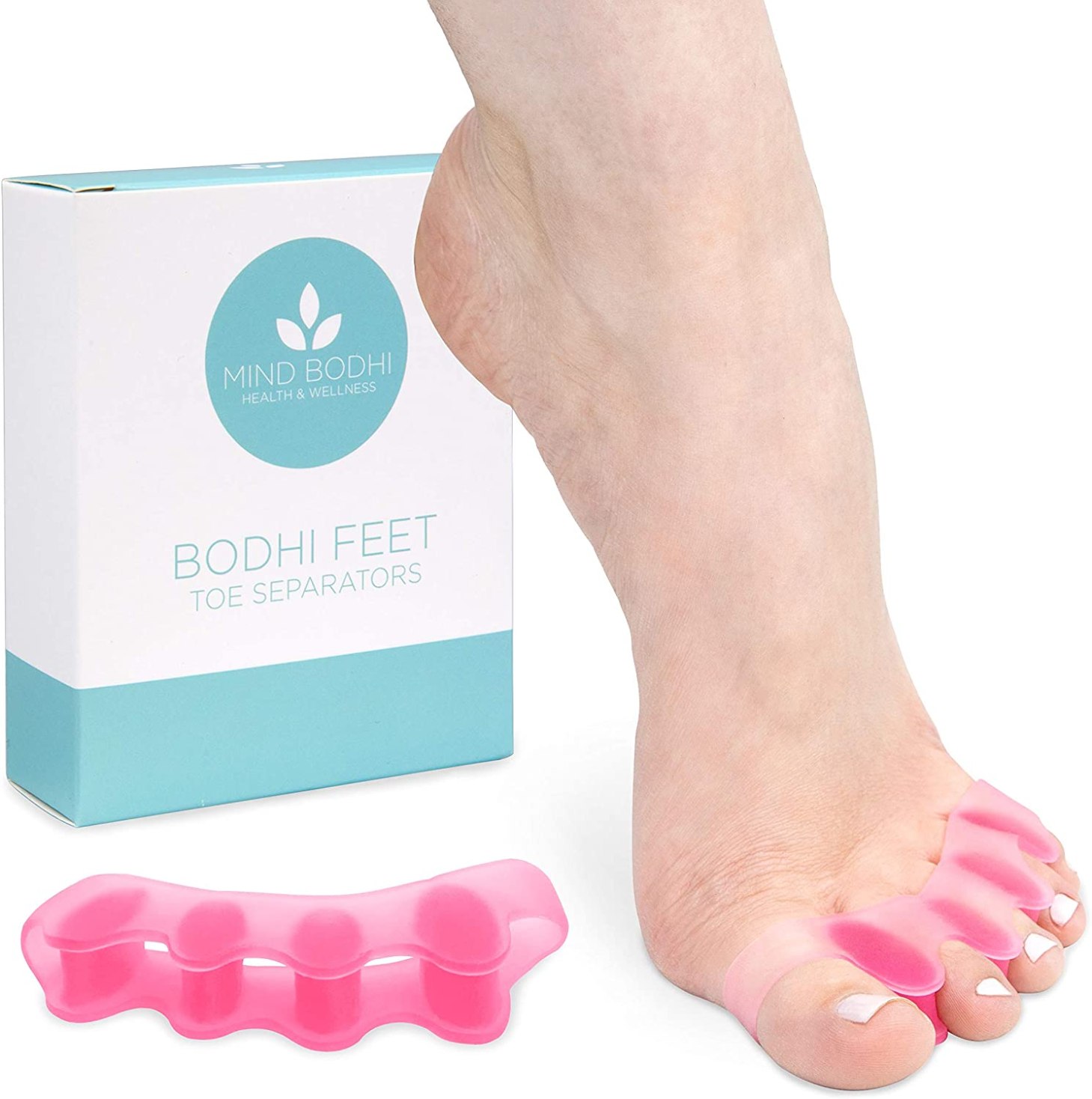
Sizes: One size
Because of their smaller profile, Dr. Splichal recommends these Mind Bodhi separators to anyone with smaller toes or feet, who might benefit from a lower-intensity stretch. Like Correct Toes, most customers report that these can be worn while walking, exercising, or in shoes. However, while they’re made from a soft and flexible medical-grade gel, they’re only available in one size option so they might not be the best pick for folks with larger feet. In fact, some people reported rolling or bunching when the fit was too tight.
Colors: 4
Pros:
- Thin enough to wear with shoes
- Highly rated
- Available in four colors
Cons:
- Only one size option
- A too-tight fit may cause rolling or bunching
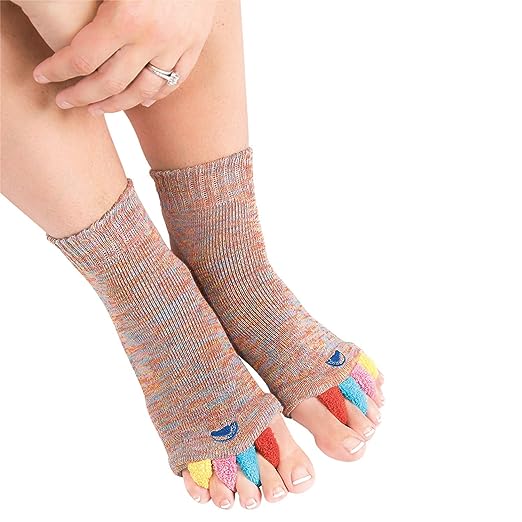
Sizes: Small (Women’s 4-6, Men’s 2-4), Medium (Women’s 7-9, Men’s 5-8), Large (Women’s 10-13, Men’s 9-12)
If the idea of gel or silicone between your toes seems a little too intense, you might want to start off with some toe separator socks. These toe socks are made from a blend of cotton, polyester, and elastane, and are machine washable for easy cleaning. They also come in three unisex sizes to accommodate most feet and a variety of fun colors. Customers say they’re soft and comfortable, although several folks warn that they’re rather thick, so they’re not a good fit for wearing inside shoes.
Colors: 11
Pros:
- Softer than silicone models
- Machine washable
- Good variety of sizes and colors
Cons:
- Some customers say they’re not dryer-friendly
- Thick
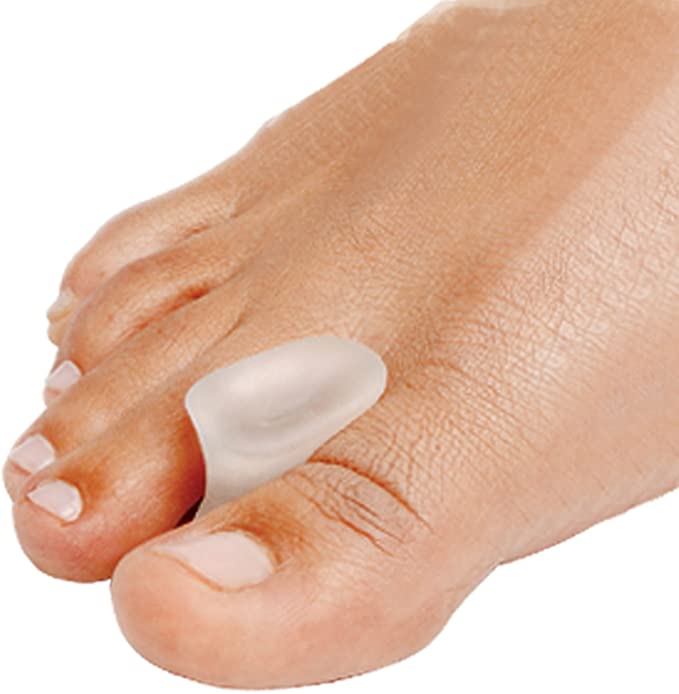
Sizes: Large
“Look for products made of silicone or foam rubber, as these materials are soft and comfortable,” says Daniel Pledger, a podiatrist and founder of ePodiatrists. He recommends these toe separators from Pedifix, which are made of a soft, flexible gel that molds to your feet. “They’re comfortable to wear and do a great job of separating your toes,” he adds. While this pack of four individual spacers can be helpful for targeted relief, it’s worth noting that the limited sizing may not suit all foot types.
Colors: Clear
Pros:
- Individual spacers for targeted relief
- Podiatrist-recommended
- Soft, flexible gel
Cons:
- Limited sizing options
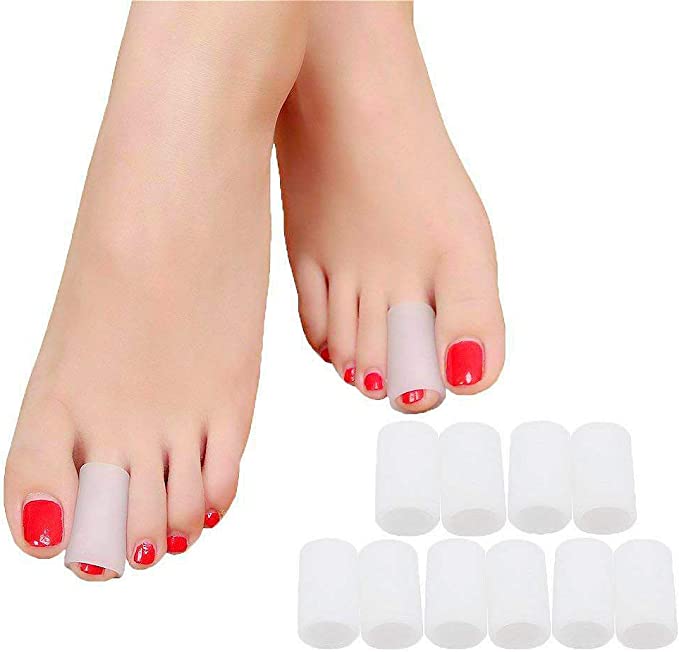
Sizes: One size fits most
“Depending on your specific toe problem, I tend to gravitate towards the sleeve-type devices made of silicone/gel,” says Marion Parke, a podiatrist and luxury shoe designer. She says the sleeve-type toe separators typically stay in place better than the crescent-shaped type. In addition, silicone and gel materials are nice because the durable material doesn’t compress over time, and they usually can be easily washed with a gentle soap and water, and are more durable. These silicone toe sleeves come in a pack of 10 and can be trimmed to fit your toes. Plus, depending on the fit, you may be able to wear these with shoes.
Colors: Clear
Pros:
- 10 individual, trimmable sleeves for customized care
- Can be worn in most shoes
- Podiatrist-recommended
Cons:
- Only one circumference size
Things to consider before buying
With or without shoes: If you’re hoping to train your feet day in and out, you’ll want to choose a pair of spacers that are thin enough to wear inside your shoes. If you’re comfortable only using your spacers for a shorter time each day, you’ll likely be set with a chunkier pair.
Size options: While toe spacers are designed to be stretchy and soft, it’s still important to find a fit that doesn’t feel too tight or too loose. If you have especially small or large feet, search for a brand that caters to your foot size.
Durability: If you’re new to toe spacers, you may want to start with a less expensive pair to see how you like them. However, many reviewers comment that the financial investment was worth it when they switched to pricier, more durable models, like YogaToes or Correct Toes.
FAQ
Is it OK to wear toe separators all day?
According to Dr. Splichal, you should begin by wearing toe separators for a few minutes each day, then increasing the length of time as you get used to them. If you feel comfortable wearing them all day, you can!
What is the difference between toe spacers and toe separators?
While brands use different terminology, there isn’t a difference between toe spacers and toe separators. Both work to stretch the toes and feet to encourage better alignment.
What are the negatives of toe spacers?
Toe spacers are generally safe for use, but can be uncomfortable, especially at first. If your toe spacers are too small, they can cut off circulation between your toes—if that’s the case, consider swapping them for a larger size. If you choose a pair of toe separators that you can wear inside your shoes, be sure to try them out over a short period of time. That way, if they bunch or roll up inside your shoes, you can take them off quickly and avoid uncomfortable rubbing or blisters.
Looking to try out a few active stretches that tackle the whole foot? Follow along with trainer Traci Copeland here:
- Ying, Jianhua et al. “Adjusted Indirect and Mixed Comparisons of Conservative Treatments for Hallux Valgus: A Systematic Review and Network Meta-Analysis.” International journal of environmental research and public health vol. 18,7 3841. 6 Apr. 2021, doi:10.3390/ijerph18073841
- Abdalbary, Sahar Ahmed. “Foot Mobilization and Exercise Program Combined with Toe Separator Improves Outcomes in Women with Moderate Hallux Valgus at 1-Year Follow-up A Randomized Clinical Trial.” Journal of the American Podiatric Medical Association vol. 108,6 (2018): 478-486. doi:10.7547/17-026
Loading More Posts...